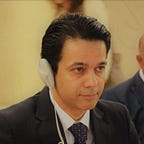Pakistan’s Growing Iran Problem
Last week, Pakistani and Iranian army chiefs talked terrorism over the phone. But the official readouts by their respective militaries could not be more different. This is the latest sign of simmering tensions between Tehran and Islamabad that have wider implications for next-door Afghanistan and the Gulf.
Around the same time that the Iranian and Pakistani commanders spoke, Pakistan’s foreign minister stood in the parliament and Iran of pushing up to 5,000 Pakistanis — visiting Iran’s Shia Muslim shrines — through the border despite pleas to wait. Aside from the blatant mistreatment of Pakistani visitors, the Iranian move introduced COVID-19 into Pakistan, and caused a security alert. Tehran is likely to have used the confusion to ‘return’ some IRGC-trained in the Zeynabioun Brigade who fought in Syria. Iran had been demanding Pakistan to accept them back for months, to no avail.
Pakistan’s forty-year-old policy of avoiding getting into the crosshairs of Iran’s ayatollahs is facing a challenge as the Revolutionary Guards set their eyes on Pakistan while the two countries compete for strategic interests in Afghanistan and the Persian Gulf. The new head of Iran’s , who replaced Soleimani, is an Afghanistan expert who has given Pakistan a
The Buleda attack of May 8, 2020 comes almost a year after a similar incident where Iran-based attackers captured and executed 14 Pakistani navy and air force personnel at before fleeing back to Iran. Pakistani Prime Minister Imran Khan visited Iran immediately afterwards to appease Iran’s rulers, only to see a few weeks later the only five-star hotel at Pakistan’s strategic port city of Gwadar attacked in a sophisticated operation on May 11, 2019. That attack occurred only a few hours before the attack on oil tankers off Fujairah port in the Gulf of Oman, not far from the site of the Pakistani attack, and two days before the attack on Saudi oil installations.
Ahmed Quraishi is a journalist based in Islamabad and Dubai who covers national security.
Originally published at https://www.unitedagainstnucleariran.com.
